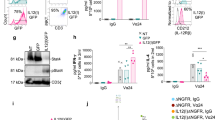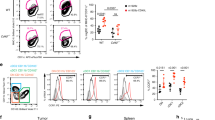Abstract
The anti-tumor efficacy of adoptively transferred T cells requires their in vivo persistence and memory polarization. It is unknown if human chimeric antigen receptor (CAR)-expressing T cells can also undergo memory polarization. We examined the functional status of CAR CD8+ T cells, re-directed to Lewis Y antigen (LeY-T), throughout a period of ex vivo expansion. Immediately before culture CD8+ T cells comprised a mixture of phenotypes including naive (CD45RA+/CCR7+/CD27+/CD28+/perforin−), central memory (CM, CD45RA−/CCR7lo/CD27+/CD28+/perforinlo), effector memory (EM, CD45RA−/CCR7−/CD27+/CD28+/perforinmod) and effector (Eff, CD45RA+/CCR7−/CD27−/CD28−/perforinhi) cells. After transduction and expansion culture of peripheral blood mononuclear cells from normal donors or multiple myeloma patients, CD8+ LeY-T cells polarized to EM- and CM-like phenotype. CD8+ LeY-T cells differed from starting CD8+ CM and EM T cells in that CD27, but not CD28, was downregulated. In addition, CD8+ LeY-T cells expressed high levels of perforin, similar to starting CD8+ Eff. CD8+ LeY-T cells also showed hallmarks of both memory and Eff function, underwent homeostatic proliferation in response to interleukin (IL)-15, and showed interferon (IFN)-γ production and cytotoxicity in response to Le-Y antigen on OVCAR-3 (human ovarian adenocarcinoma) cells. This study confirms CD8+ LeY-T cells have a CM- and EM-like phenotype and heterogeneous function consistent with potential to persist in vivo after adoptive transfer.
This is a preview of subscription content, access via your institution
Access options
Subscribe to this journal
Receive 12 print issues and online access
$259.00 per year
only $21.58 per issue
Buy this article
- Purchase on Springer Link
- Instant access to full article PDF
Prices may be subject to local taxes which are calculated during checkout







Similar content being viewed by others
References
Bollard CM, Aguilar L, Straathof KC, Gahn B, Huls MH, Rousseau A et al. Cytotoxic T lymphocyte therapy for Epstein-Barr virus+ Hodgkin's disease. J Exp Med 2004; 200: 1623–1633.
Gattinoni L, Powell Jr DJ, Rosenberg SA, Restifo NP . Adoptive immunotherapy for cancer: building on success. Nat Rev Immunol 2006; 6: 383–393.
Riddell SR, Walter BA, Gilbert MJ, Greenberg PD . Selective reconstitution of CD8+ cytotoxic T lymphocyte responses in immunodeficient bone marrow transplant recipients by the adoptive transfer of T cell clones. Bone Marrow Transplant 1994; 14 (Suppl 4): S78–S84.
Haynes NM, Smyth MJ, Kershaw MH, Trapani JA, Darcy PK . Fas-ligand-mediated lysis of erbB-2-expressing tumour cells by redirected cytotoxic T lymphocytes. Cancer Immunol Immunother 1999; 47: 278–286.
Darcy PK, Kershaw MH, Trapani JA, Smyth MJ . Expression in cytotoxic T lymphocytes of a single-chain anti-carcinoembryonic antigen antibody. Redirected Fas ligand-mediated lysis of colon carcinoma. Eur J Immunol 1998; 28: 1663–1672.
Haynes NM, Trapani JA, Teng MW, Jackson JT, Cerruti L, Jane SM et al. Rejection of syngeneic colon carcinoma by CTLs expressing single-chain antibody receptors codelivering CD28 costimulation. J Immunol 2002; 169: 5780–5786.
Moeller M, Haynes NM, Kershaw MH, Jackson JT, Teng MW, Street SE et al. Adoptive transfer of gene-engineered CD4+ helper T cells induces potent primary and secondary tumor rejection. Blood 2005; 106: 2995–3003.
Murphy A, Westwood JA, Brown LE, Teng MW, Moeller M, Xu Y et al. Antitumor activity of dual-specific T cells and influenza virus. Cancer Gene Ther 2007; 14: 499–508.
Gattinoni L, Klebanoff CA, Palmer DC, Wrzesinski C, Kerstann K, Yu Z et al. Acquisition of full effector function in vitro paradoxically impairs the in vivo antitumor efficacy of adoptively transferred CD8+ T cells. J Clin Invest 2005; 115: 1616–1626.
Palmer DC, Balasubramaniam S, Hanada K, Wrzesinski C, Yu Z, Farid S et al. Vaccine-stimulated, adoptively transferred CD8+ T cells traffic indiscriminately and ubiquitously while mediating specific tumor destruction. J Immunol 2004; 173: 7209–7216.
Klebanoff CA, Gattinoni L, Torabi-Parizi P, Kerstann K, Cardones AR, Finkelstein SE et al. Central memory self/tumor-reactive CD8+ T cells confer superior antitumor immunity compared with effector memory T cells. Proc Natl Acad Sci USA 2005; 102: 9571–9576.
Morimoto J, Tan X, Teague RM, Ohlen C, Greenberg PD . Induction of tolerance in CD8+ T cells to a transgenic autoantigen expressed in the liver does not require cross-presentation. J Immunol 2007; 178: 6849–6860.
Teague RM, Sather BD, Sacks JA, Huang MZ, Dossett ML, Morimoto J et al. Interleukin-15 rescues tolerant CD8+ T cells for use in adoptive immunotherapy of established tumors. Nat Med 2006; 12: 335–341.
Milone MC, Fish JD, Carpenito C, Carroll RG, Binder GK, Teachey D et al. Chimeric receptors containing CD137 signal transduction domains mediate enhanced survival of T cells and increased antileukemic efficacy in vivo. Mol Ther 2009; 17: 1453–1464.
Carpenito C, Milone MC, Hassan R, Simonet JC, Lakhal M, Suhoski MM et al. Control of large, established tumor xenografts with genetically retargeted human T cells containing CD28 and CD137 domains. Proc Natl Acad Sci USA 2009; 106: 3360–3365.
Rosenberg SA, Yannelli JR, Yang JC, Topalian SL, Schwartzentruber DJ, Weber JS et al. Treatment of patients with metastatic melanoma with autologous tumor-infiltrating lymphocytes and interleukin 2. J Natl Cancer Inst 1994; 86: 1159–1166.
Huang J, Khong HT, Dudley ME, El-Gamil M, Li YF, Rosenberg SA et al. Survival, persistence, and progressive differentiation of adoptively transferred tumor-reactive T cells associated with tumor regression. J Immunother 2005; 28: 258–267.
Robbins PF, Dudley ME, Wunderlich J, El-Gamil M, Li YF, Zhou J et al. Cutting edge: persistence of transferred lymphocyte clonotypes correlates with cancer regression in patients receiving cell transfer therapy. J Immunol 2004; 173: 7125–7130.
Pule MA, Savoldo B, Myers GD, Rossig C, Russell HV, Dotti G et al. Virus-specific T cells engineered to coexpress tumor-specific receptors: persistence and antitumor activity in individuals with neuroblastoma. Nat Med 2008; 14: 1264–1270.
Lamers CH, Langeveld SC, Groot-van Ruijven CM, Debets R, Sleijfer S, Gratama JW . Gene-modified T cells for adoptive immunotherapy of renal cell cancer maintain transgene-specific immune functions in vivo. Cancer Immunol Immunother 2007; 56: 1875–1883.
Teng MW, Kershaw MH, Jackson JT, Smyth MJ, Darcy PK . Adoptive transfer of chimeric FcepsilonRI gene-modified human T cells for cancer immunotherapy. Hum Gene Ther 2006; 17: 1134–1143.
Morgan RA, Dudley ME, Wunderlich JR, Hughes MS, Yang JC, Sherry RM et al. Cancer regression in patients after transfer of genetically engineered lymphocytes. Science 2006; 314: 126–129.
Klebanoff CA, Finkelstein SE, Surman DR, Lichtman MK, Gattinoni L, Theoret MR et al. IL-15 enhances the in vivo antitumor activity of tumor-reactive CD8+ T cells. Proc Natl Acad Sci USA 2004; 101: 1969–1974.
Klebanoff CA, Gattinoni L, Restifo NP . CD8+ T-cell memory in tumor immunology and immunotherapy. Immunol Rev 2006; 211: 214–224.
Geginat J, Lanzavecchia A, Sallusto F . Proliferation and differentiation potential of human CD8+ memory T-cell subsets in response to antigen or homeostatic cytokines. Blood 2003; 101: 4260–4266.
Appay V, Dunbar PR, Callan M, Klenerman P, Gillespie GM, Papagno L et al. Memory CD8+ T cells vary in differentiation phenotype in different persistent virus infections. Nat Med 2002; 8: 379–385.
Lanzavecchia A, Sallusto F . Understanding the generation and function of memory T cell subsets. Curr Opin Immunol 2005; 17: 326–332.
Wherry EJ, Ahmed R . Memory CD8 T-cell differentiation during viral infection. J Virol 2004; 78: 5535–5545.
Barber A, Zhang T, Megli CJ, Wu J, Meehan KR, Sentman CL . Chimeric NKG2D receptor-expressing T cells as an immunotherapy for multiple myeloma. Exp Hematol 2008; 36: 1318–1328.
Till BG, Jensen MC, Wang J, Chen EY, Wood BL, Greisman HA et al. Adoptive immunotherapy for indolent non-Hodgkin lymphoma and mantle cell lymphoma using genetically modified autologous CD20-specific T cells. Blood 2008; 112: 2261–2271.
Westwood JA, Smyth MJ, Teng MW, Moeller M, Trapani JA, Scott AM et al. Adoptive transfer of T cells modified with a humanized chimeric receptor gene inhibits growth of Lewis-Y-expressing tumors in mice. Proc Natl Acad Sci USA 2005; 102: 19051–19056.
Seder RA, Ahmed R . Similarities and differences in CD4+ and CD8+ effector and memory T cell generation. Nat Immunol 2003; 4: 835–842.
Kershaw MH, Teng MW, Smyth MJ, Darcy PK . Supernatural T cells: genetic modification of T cells for cancer therapy. Nat Rev Immunol 2005; 5: 928–940.
Muul LM, Tuschong LM, Soenen SL, Jagadeesh GJ, Ramsey WJ, Long Z et al. Persistence and expression of the adenosine deaminase gene for 12 years and immune reaction to gene transfer components: long-term results of the first clinical gene therapy trial. Blood 2003; 101: 2563–2569.
Westwood JA, Murray WK, Trivett M, Shin A, Neeson P, MacGregor DP et al. Absence of retroviral vector-mediated transformation of gene-modified T cells after long-term engraftment in mice. Gene Ther 2008; 15: 1056–1066.
Acknowledgements
Funding for this study came from the National Health and Medical Research Council of Australia, Program Grant no. 454569, the Peter MacCallum Cancer Center Morris Family Grant and the Leukemia Lymphoma Society (6073-06). MH Kershaw and PK Darcy were supported by a NHMRC Senior Research Fellowship and Career Development Award respectively. MJ Smyth and JA Trapani were supported by NHMRC Senior Principal Research Fellowships.
Author information
Authors and Affiliations
Corresponding author
Ethics declarations
Competing interests
The authors declare no conflict of interest.
Additional information
Supplementary Information accompanies the paper on Gene Therapy website
Rights and permissions
About this article
Cite this article
Neeson, P., Shin, A., Tainton, K. et al. Ex vivo culture of chimeric antigen receptor T cells generates functional CD8+ T cells with effector and central memory-like phenotype. Gene Ther 17, 1105–1116 (2010). https://doi.org/10.1038/gt.2010.59
Received:
Revised:
Accepted:
Published:
Issue Date:
DOI: https://doi.org/10.1038/gt.2010.59
Keywords
This article is cited by
-
Novel CAR T therapy is a ray of hope in the treatment of seriously ill AML patients
Stem Cell Research & Therapy (2021)
-
Venetoclax imparts distinct cell death sensitivity and adaptivity patterns in T cells
Cell Death & Disease (2021)
-
Effector memory and central memory NY-ESO-1-specific re-directed T cells for treatment of multiple myeloma
Gene Therapy (2013)
-
Persistence and Efficacy of Second Generation CAR T Cell Against the LeY Antigen in Acute Myeloid Leukemia
Molecular Therapy (2013)
-
In vitro generated anti-tumor T lymphocytes exhibit distinct subsets mimicking in vivo antigen-experienced cells
Cancer Immunology, Immunotherapy (2011)



